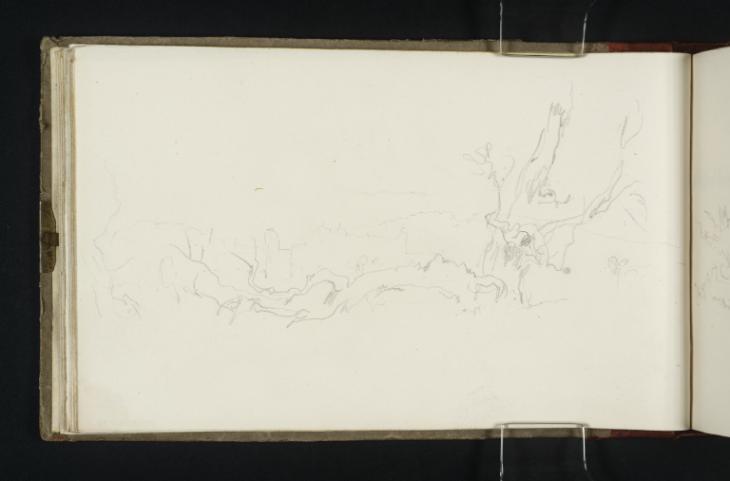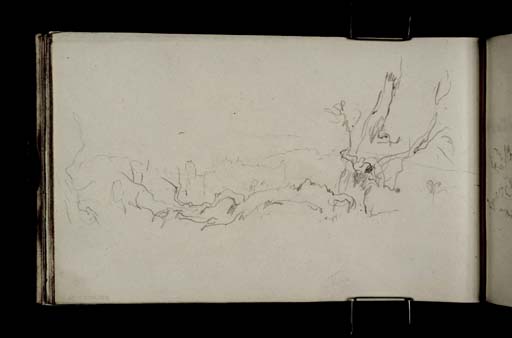Joseph Mallord William Turner A Blasted Oak, Possibly at Cobham Hall c.1821-2
Image 1 of 2
Joseph Mallord William Turner,
A Blasted Oak, Possibly at Cobham Hall
c.1821-2
Joseph Mallord William Turner 1775–1851
Folio 19 Verso:
A Blasted Oak, Possibly at Cobham Hall c.1821–2
D17238
Turner Bequest CXCVIII 19a
Turner Bequest CXCVIII 19a
Pencil on white wove paper, 113 x 187 mm
Partial watermark ‘T Edm | 18’
Partial watermark ‘T Edm | 18’
Accepted by the nation as part of the Turner Bequest 1856
References
1909
A.J. Finberg, A Complete Inventory of the Drawings of the Turner Bequest, London 1909, vol.I, p.604, CXCVIII 19 a, as ‘A blasted oak’.
This page is dominated by the wild corpse of a dramatically split tree in the foreground. Half of the gnarled trunk is strewn across the drawing horizontally, arching up from the roots on the far right of the drawing and bending further towards the ground at the opposite end of its length where it bursts into spidery veins of smaller branches and twigs. The other half remains standing, but leans off towards the gutter of the sketchbook on then right. Turner renders the split in the trunk with a heavy hand, pushing his pencil into dark crevices and drawing out a tangible wound from the torn flesh of the tree.
Turner’s elaboration of peaked towers in the distance is similar to examples of his handling of the architecture at Cobham Hall near Rochester. A manor house has been positioned on the site since 1208, undergoing various bouts of remodelling in the intervening years and becoming home to a boarding school for girls in 1962.1 What might distinguish the present sketch as one of Cobham are the distinctive peaks of the towers; globular blooming roofs which are pinched into a spike at their summit. Twin towers echoing this design flank the Elizabethan wings of the building, which were built for William Brooke, 10th Lord of the manor, in 1559.2
Cobham is situated close to Rochester and, as noted by Ian Warrell, Turner depicts it several times towards the final pages of this sketchbook on folios 82 verso, 83 recto, and 84 recto (D17348, D17349, D17351).3 It seems plausible that there are additional drawings of the building as well, of which the present page is one and folio 20 recto (D17239) another. Turner also made more detailed studies of Cobham Hall in the earlier River and Margate sketchbook of about 1805–9 (Tate D06484, D06485, D06496, D06498, D06500; Turner Bequest XCIX 71a, 72, 78a, 79a, 80a).
It is difficult to say for certain whether it is Cobham that features in the present work, but certainly judging from the surrounding pages Turner was making studies of proximate areas at a similar time.
Maud Whatley
January 2016
‘300–1700’, Cobham Hall, accessed 1 November 2015, http://www.cobhamhall.com/historic-house/cobham-hall-through-the-ages/300-1700/ .
How to cite
Maud Whatley, ‘A Blasted Oak, Possibly at Cobham Hall c.1821–2 by Joseph Mallord William Turner’, catalogue entry, January 2016, in David Blayney Brown (ed.), J.M.W. Turner: Sketchbooks, Drawings and Watercolours, Tate Research Publication, February 2017, https://www


